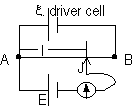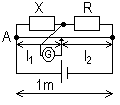




| Ammeter | Voltmeter |
| measures current | measure pd bet 2 pts |
| series connection | // connection w/ device whose potential drop is being measure |
| v. low R (should not affect current being measured) | v. high R (negligible I through voltmeter > no pd across voltmeter) |
| IA = V/(R+RA) RA<<R (RA → 0) => IA → V/R => IA ≈ I | IV = V/RT = V(R+RV)/RRV = V (1/R + 1/RV) RV>>R (RV → ∞) => IV → V/R => IV ≈ I |








